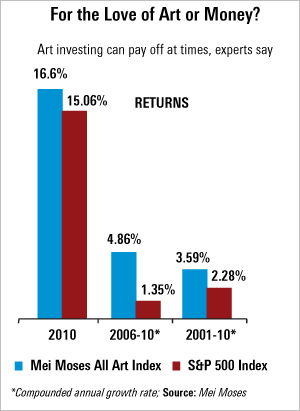 Art is in vogue as an investment, and several factors appear to be driving the interest. The financial markets’ recovery has increased wealthy investors’ confidence, and that increase is being reflected in their spending patterns.
Art is in vogue as an investment, and several factors appear to be driving the interest. The financial markets’ recovery has increased wealthy investors’ confidence, and that increase is being reflected in their spending patterns.
According to the Capgemini and Merrill Lynch World Wealth Report 2010, “[T]he demand for passion investments overall is expected to increase … as wealth levels rebound. This is evidenced by the fact that auction houses, luxury goods makers and high-end service providers all reported signs of renewed demand toward the end of 2009, and in the early part of 2010.”
Art’s recent financial performance as an asset class is another factor. The Mei Moses All Art Index grew by 16.06% in 2010 versus a 15.06% total return for the S&P 500.
From a longer term perspective, according to Mei Moses, art has had compound annual returns of 4.86% for the most recent five years and 3.59% over the past decade, exceeding the S&P’s returns of 1.35% and 2.28% respectively.
Fine-art investments pose several challenges, though. Investors need niche-market expertise to avoid mispricing purchases and sales, and misjudging market trends.
In addition, building a diversified collection of high-end art without creating excessive exposure to the illiquid asset class takes substantial wealth.
And there are problems with storage and security: As a tangible, portable asset, art pieces are at risk for damage and theft.
These challenges have led to a growing interest in professionally managed art funds aimed at wealthy investors.
Art-Focused Funds
Randall Willette, a managing director of Fine Art Wealth Management Ltd. in London, estimates that there are between 30 to 40 art and collectible investment vehicles globally, including those that are under development and/or sitting on the sidelines waiting for investors to return.
Players in this market consist primarily of specialist investment-management boutiques, private banks, family offices and a growing number of alternative-fund providers looking to integrate art into their overall offerings.
According to Rhea Papanicolaou with the Fine Art Fund Group in London, the rationale behind most art funds is fairly similar.
Works of art are bought at a competitive price and stored in warehouses or on private exhibition, only to be sold for a profit a few months or years later, she says.








 February 18, 2011 at 05:42 AM
February 18, 2011 at 05:42 AM










